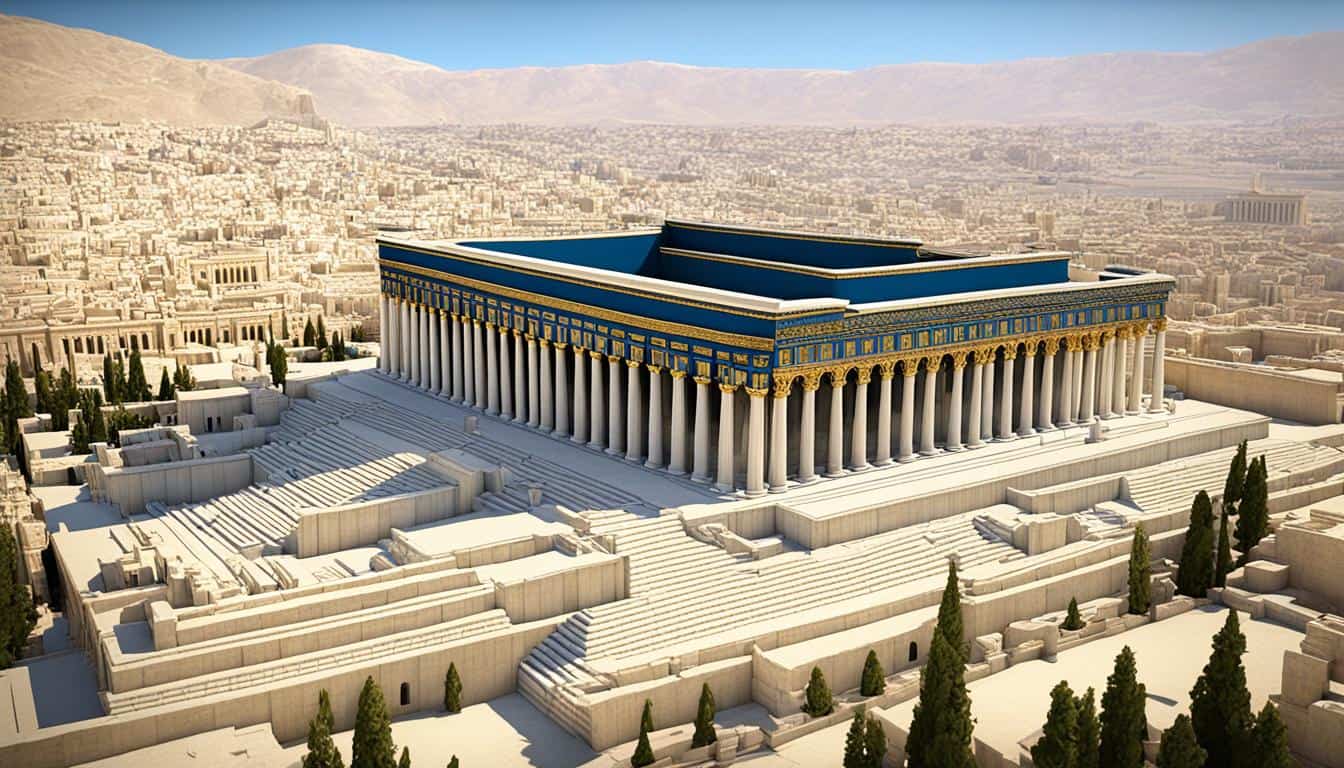Table of Contents
Have you ever wondered about the rich history behind the iconic Western Wall? How did it come to be such a significant symbol for so many? Let’s uncover the fascinating story of the Second Temple and how its legacy endures today.
The Second Temple, also known as Herod’s Temple, played a pivotal role in Jewish history and religion. It witnessed extraordinary events and underwent remarkable transformations throughout its existence. From grand construction to dramatic destruction, the Second Temple holds the key to understanding the Jewish people’s resilience and faith.
The Big Rebuild (516 BCE)
In 516 BCE, after the devastating destruction of the first Temple, the community came together to embark on an ambitious project: the rebuilding of the Second Temple. This grand construction endeavor aimed to recreate a magnificent place of worship that would once again symbolize the spiritual and cultural center of the Jewish community.
The reconstruction of the Second Temple was not merely a physical undertaking but a collective effort that represented the resilience and determination of the Jewish people. It required meticulous planning, skilled labor, and the generous contributions of both time and resources from the community.
Under the leadership of leaders such as Zerubbabel and Joshua the High Priest, the reconstruction project took shape. The Second Temple would incorporate the lessons learned from the past and be designed to reflect the grandeur of its predecessor.
The completion of the Second Temple was a momentous event that marked the revival of a sacred space and the restoration of a community’s faith and identity. It stood as a testament to the resilience and unwavering spirit of the Jewish people.
“The journey to rebuild the Second Temple was a testament to our collective strength and determination. We poured our heart and soul into creating a structure that would honor our traditions and connect us with the divine.” – Anonymous Community Member
Throughout the reconstruction process, the community’s dedication and commitment were evident in every detail of the Second Temple. From the selection of the finest materials to the intricate craftsmanship, no effort was spared in creating a sacred space that would inspire awe and reverence.
As the construction progressed, the Second Temple rose majestically, reclaiming its place as a beacon of hope and spirituality. The community’s shared vision and unwavering support transformed the grand construction into a symbol of unity and perseverance.
https://www.youtube.com/watch?v=77fOyCNwUM0
The rebuilding of the Second Temple stands as a testament to the indomitable human spirit and the power of collective action. It is a reminder that even in the face of adversity, we have the ability to rebuild, to create, and to inspire.
Redecorating with the Persians (Around 458 BCE)
During the reign of the Second Temple, a significant transformation took place under the guidance of Ezra, with the generous support of the Persian king. This period marked an era of lavish decorations and architectural enhancements, turning the temple into a truly breathtaking place of worship.
Revitalizing the Sacred Space
Under the sponsorship of the Persian king, Ezra spearheaded a project to decorate and renovate the Second Temple. The aim was to elevate its grandeur and create an awe-inspiring environment for worshipers.
Ezra and his team spared no expense, employing skilled artisans and craftsmen to craft intricate designs and exquisite details that adorned the walls, ceilings, and interior of the temple. Precious metals, including gold and silver, were used to embellish the sacred space, reflecting the splendor and opulence of the era.
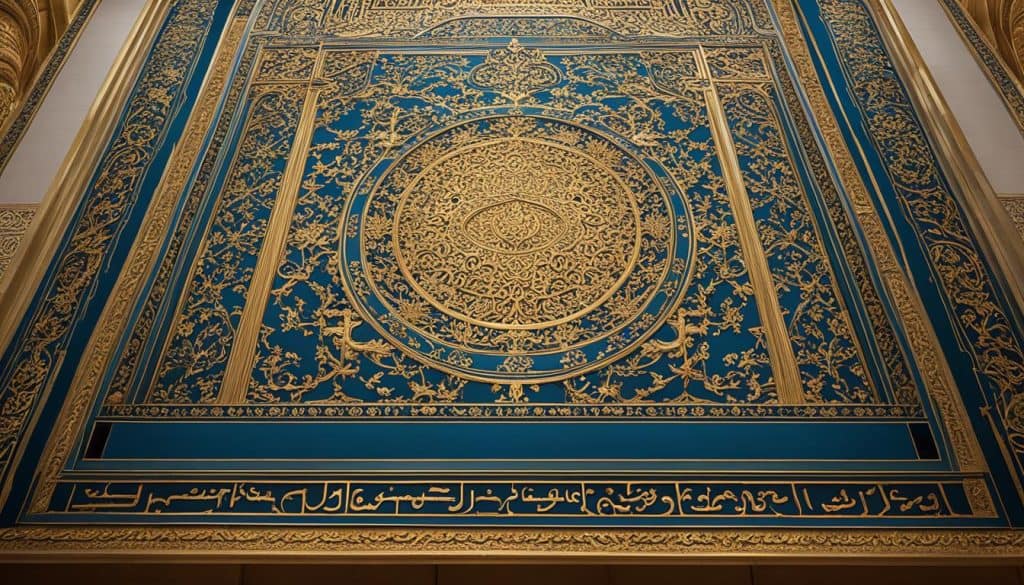
A Visual Feast for the Eyes
The temple’s decorations were not limited to precious metals alone. The walls were adorned with intricate murals, depicting biblical scenes and symbolizing the divine connection between worshipers and their faith.
Fine tapestries and elaborate carpets were also added, enhancing the visual appeal and providing a sense of warmth and comfort within the sacred space. Delicate sculptures and ornate carvings adorned the pillars and entranceways, capturing the essence of beauty and spirituality.
A Testament to Persian Patronage
“With the support and patronage of the Persian king, Ezra succeeded in transforming the Second Temple into a stunning masterpiece. The decorations not only magnified the temple’s aesthetic beauty, but they also symbolized the prosperous relationship between the Persian empire and the Jewish community.”
The Persian king’s contribution showcased his appreciation for the Jewish faith and the importance of the Second Temple as a center of worship. It was a testament to the harmonious coexistence between different cultures and religions during this period of history.
Preserving a Legacy
The lavish decorations and enhancements of the Second Temple during the Persian era left an indelible mark on the religious and cultural history of the Jewish people. Despite the temple’s eventual destruction, the memory of its grandeur and splendor lives on.
Today, as we reflect on the Second Temple’s magnificence, we are reminded of the enduring legacy it has left behind. Its decorations served as a visual representation of the devotion and faith of worshipers, and their commitment to creating a sacred space worthy of their beliefs.
A Bigger, Better Makeover by Herod (20 BCE)
When it comes to the Second Temple, the name Herod the Great is synonymous with grandeur and opulence. Under his reign, the Second Temple underwent a massive construction project that transformed it into an architectural marvel.
Herod the Great, known for his ambitious building projects, spared no expense in making the Second Temple a symbol of his power and magnificence. He aimed to surpass the splendor of the original temple and create a structure that would be revered for generations to come.
Herod’s renovation and expansion of the Second Temple were nothing short of extraordinary. The massive construction project included expanding the temple complex and adding awe-inspiring courtyards, colonnades, and intricate architectural details.
The scale of the project was immense. It involved the work of thousands of workers and spanned several years. The result was a temple complex that stood as a testament to Herod’s vision and ambition.
“The temple that Herod built was one of the most impressive structures of its time. The grandeur and beauty of the Second Temple were unmatched, attracting visitors from far and wide.”
The renovations made by Herod went beyond just the physical structure. He also invested in beautifying the temple with lavish decorations and precious materials. Gold, marble, and intricate mosaics adorned the walls, ceilings, and floors, creating a captivating atmosphere.
Herod’s construction project not only elevated the physical stature of the Second Temple but also solidified its significance as the center of Jewish worship and identity. The temple became a source of immense pride and a symbol of national unity.
The Transformation of the Second Temple
Here is a glimpse of some of the remarkable changes that Herod made to the Second Temple:
| Construction and Renovations | Decorations and Enhancements |
|---|---|
| Expansion of the temple complex | Lavish use of gold, marble, and mosaics |
| Addition of grand courtyards and colonnades | Intricate carvings and architectural details |
| Renovation of the Holy of Holies | Elaborate furnishings and sacred vessels |
| Reconstruction of the outer walls | Beautification of the temple courtyards |
These changes not only enhanced the aesthetics of the Second Temple but also raised its prominence as a sacred place of worship and pilgrimage. Herod’s massive construction project cemented his legacy and left an indelible mark on the history of the Second Temple.
The Famous Standoff (66 CE)
Dive into the significant event of the Jewish resistance against Roman rule, centered around the Second Temple, and the role it played in the conflict.
The Second Temple became a symbol of Jewish identity and religious practice, and its prominence drew the attention of Roman rulers. Growing tensions between the Jewish population and the Roman Empire eventually led to a dramatic standoff.
In 66 CE, a group of Jewish rebels, known as the Sicarii, seized control of the Second Temple and expelled the Roman garrison stationed there. This act of defiance sparked a full-scale revolt against the Roman occupation.
The Sicarii and other Jewish resistance groups, such as the Zealots, fervently fought against the Roman forces. The Second Temple served as a strategic stronghold for the rebels, providing them with a symbol of hope and inspiration.
The Roman rulers, determined to crush the Jewish rebellion, deployed a large military force to quell the resistance. They laid siege to Jerusalem and ultimately breached the city walls in 70 CE.
The Roman soldiers stormed the Second Temple, setting it ablaze and leading to its destruction. The once magnificent structure, which had been rebuilt and renovated multiple times throughout history, crumbled under the might of the Roman Empire.
“The Jewish resistance during the famous standoff demonstrated their unwavering commitment to preserving their culture and faith despite the overwhelming power of the Roman Empire.”
This significant event in history serves as a testament to the enduring spirit of the Jewish people and their remarkable resistance against oppressive forces.
| Jewish Resistance | Roman Rulers | Outcome |
|---|---|---|
| • Sicarii and Zealots led the rebellion | • Roman Empire under Emperor Nero | • Destruction of the Second Temple |
| • The Second Temple served as a stronghold for the resistance | • Roman forces laid siege to Jerusalem | • Fierce resistance by the Jewish rebels |
| • Symbolic importance of the Second Temple fueled the rebellion | • Roman soldiers breached the city walls | • Complete destruction of the Temple |
The destruction of the Second Temple marked a turning point in Jewish history and had profound consequences for the Jewish people. Though the physical structure was lost, its spiritual and cultural legacy lives on, inspiring generations to remember the courage and tenacity displayed during the famous standoff.
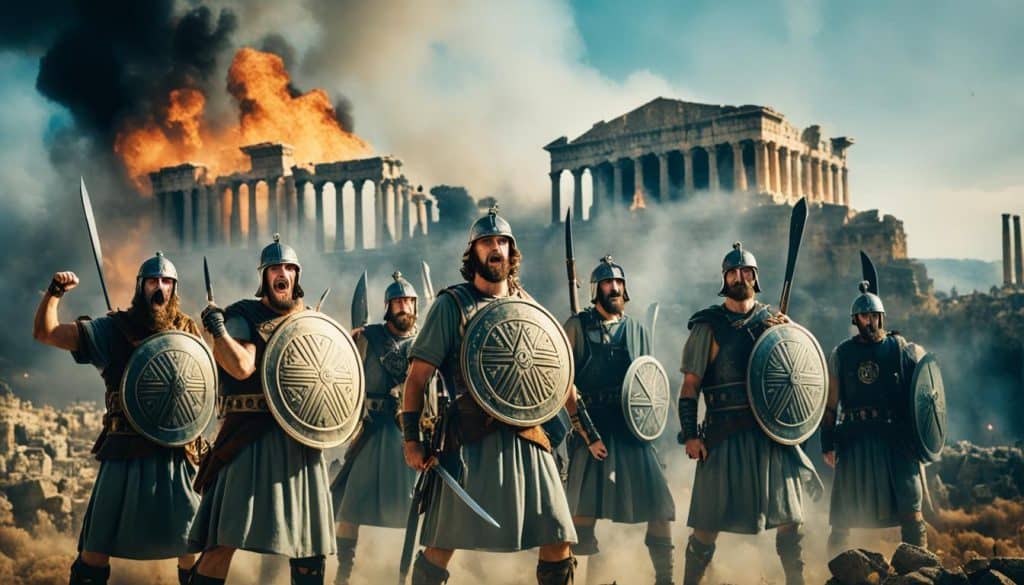
A Sad Goodbye (70 CE)
Experience the heartbreak and devastation as we delve into the tragic event of the Roman destruction of the Second Temple in 70 CE. This catastrophic event had a profound impact on the Jewish community and marked the end of an era.
Following years of conflict between the Romans and the Jewish population, the Second Temple, one of the most sacred structures in Jerusalem, was lost forever. The Roman Empire, led by General Titus, laid siege to the city, systematically destroying the magnificent temple.
“the soldiers put fire to the surrounding colonnade…the flames, breaking out on all sides together, drove the Jews upon the Roman garrison into the western court of the temple.”
– Josephus, Jewish War
The destruction of the Second Temple was not only a physical loss but also a spiritual blow to the Jewish people. This holy site had been the center of Jewish worship and a symbol of their identity and faith for centuries. The loss of the temple left a void that was felt deeply within the community.
To commemorate the tragic event, it is essential to recognize the historical significance of the Roman destruction. The loss of the Second Temple served as a catalyst for significant changes within Judaism, leading to the development of new religious practices and institutions that would preserve the faith for generations to come.
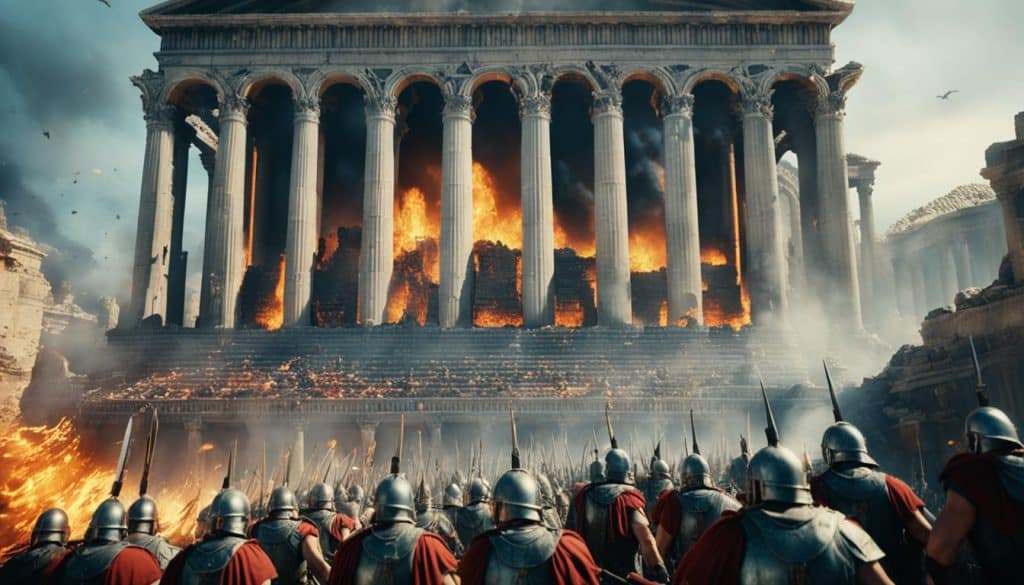
| Impact of the Roman Destruction of the Second Temple | Significance |
|---|---|
| The end of Jewish autonomy in Jerusalem | This event marked the beginning of a long period of exile and dispersion for the Jewish people. |
| Shift in religious practices | The destruction of the temple led to the rise of synagogues and a greater emphasis on prayer and study. |
| Mourning and remembrance | The Western Wall, the only remaining part of the temple complex, became a site for Jewish pilgrimage and a symbol of resilience. |
The loss of the Second Temple by Roman destruction was a deeply significant event in Jewish history. While it marked the end of an era, it also gave rise to new forms of religious expression and a renewed commitment to preserving Jewish identity. Despite the tragedy, the memory of the Second Temple lives on, serving as a reminder of the resilience and enduring spirit of the Jewish people.
The Western Wall Keeps the Memory Alive
Discover how the Western Wall, also known as the Wailing Wall, survived the destruction of the Second Temple and became a symbol of remembrance and connection for people from all over the world.
The Significance of the Western Wall
The Western Wall, located in the Old City of Jerusalem, holds tremendous historical and spiritual significance for various communities. It is considered the most sacred site in Judaism, believed to be the last remnant of the Second Temple complex, destroyed by the Romans in 70 CE. This ancient structure serves as a powerful reminder of the vibrant past and enduring resilience of the Jewish people.
“The Western Wall stands as a testament to the indomitable spirit of the Jewish people and their unwavering connection to their ancestral homeland.”
– Rabbi Avraham Goldstein
Visitors from all walks of life flock to the Western Wall to pay their respects, offer prayers, and place handwritten notes in the crevices of its ancient stones. For many, it is a place of solace, introspection, and spiritual connection.
The Rituals and Customs at the Western Wall
The Western Wall is not merely a historical monument; it is a living testament to Jewish tradition and faith. Numerous customs and rituals are observed at this sacred site:
- Prayer: Devotees engage in fervent prayer, pouring out their hearts and seeking divine blessings.
- Bar/Bat Mitzvah Celebrations: Jewish boys and girls celebrate their coming of age by reading from the Torah scroll and commemorating this milestone against the backdrop of the Western Wall.
- Notes in the Wall: People from all over the world write heartfelt prayers, wishes, and messages, which they then place within the cracks of the Western Wall. This tradition represents a tangible connection between individuals and the timeless legacy of the Jewish people.
Throughout the year, significant religious events, such as Rosh Hashanah, Yom Kippur, and Passover, draw large crowds to the Western Wall, where worshippers seek spiritual fulfillment and engage in meaningful traditions.
Holy Sites in the Old City of Jerusalem
| Site | Religious Significance |
|---|---|
| Western Wall | The holiest site in Judaism, remaining remnant of the Second Temple |
| Church of the Holy Sepulchre | Considered the holiest Christian site, believed to be the location of Jesus’ crucifixion, burial, and resurrection |
| Al-Aqsa Mosque | One of the holiest Islamic sites after Mecca and Medina, believed to be the location of Prophet Muhammad’s night journey |
The Old City of Jerusalem is a treasure trove of diverse religious heritage, with the Western Wall holding a distinct place of honor as a testament to Jewish identity and tradition.
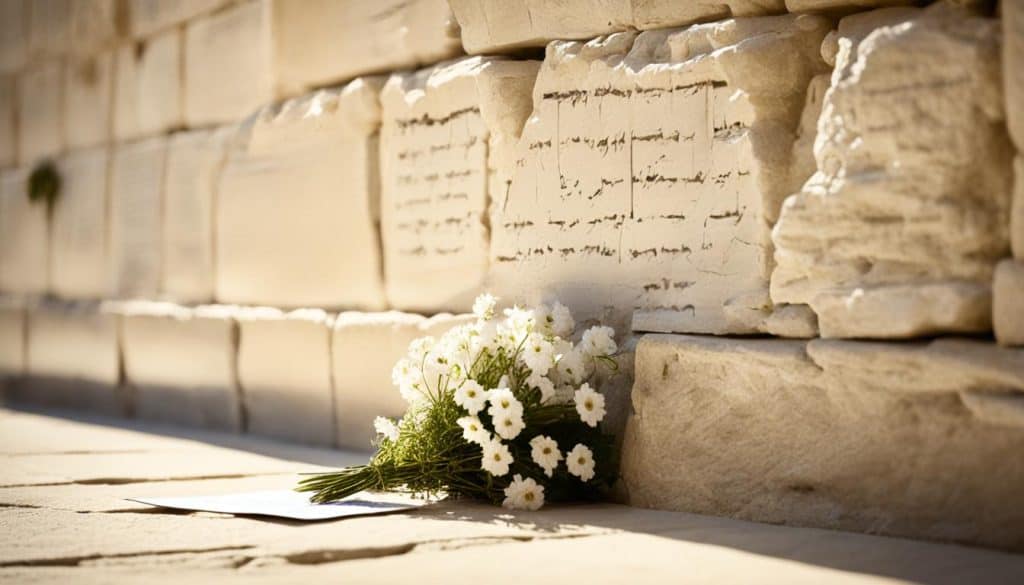
The Western Wall not only stands as a physical remnant of the Second Temple but also serves as a symbol of hope, resilience, and unity. It continues to draw people from all corners of the globe, fostering a sense of connection and shared history.
How Did the Second Temple Influence the City of Bethlehem?
The Second Temple significantly impacted key locations in Bethlehem city. It solidified the city’s status as a center of religious pilgrimage and worship, drawing visitors from far and wide. This influx of people contributed to the city’s growth and development, making it an important religious and cultural hub.
The Enduring Legacy
The Second Temple holds a significant place in history, leaving behind a lasting legacy that continues to resonate with people today. Built upon the ruins of the first temple, the Second Temple stood as a symbol of hope and faith for the Jewish community.
Throughout its existence, the Second Temple witnessed grand construction projects, extravagant decorations, and even fierce resistance against Roman rule. Its walls held the prayers and aspirations of countless individuals, serving as a place of worship and connection.
Although the Second Temple met its tragic end with the Roman destruction in 70 CE, its legacy lives on. Today, the Western Wall, also known as the Wailing Wall, remains a powerful testament to the enduring impact of the Second Temple. People from all corners of the world flock to this sacred site, offering prayers and seeking solace.
The legacy of the Second Temple extends beyond its physical remnants. It represents the resilience and strength of a community that, despite adversity, continues to find hope and inspiration in their shared history. The Second Temple stands as a reminder of the power of faith, the importance of cultural heritage, and the lasting impact of human endeavors.

